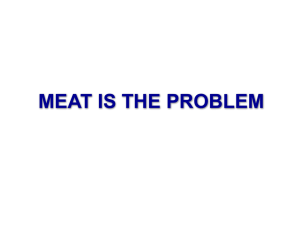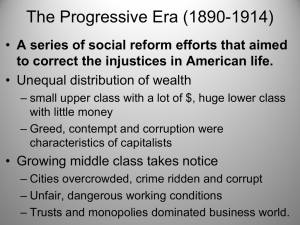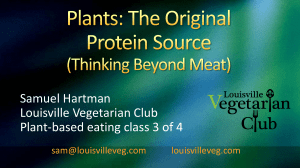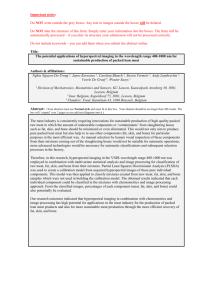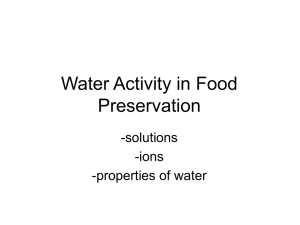Risk Evaluation
advertisement
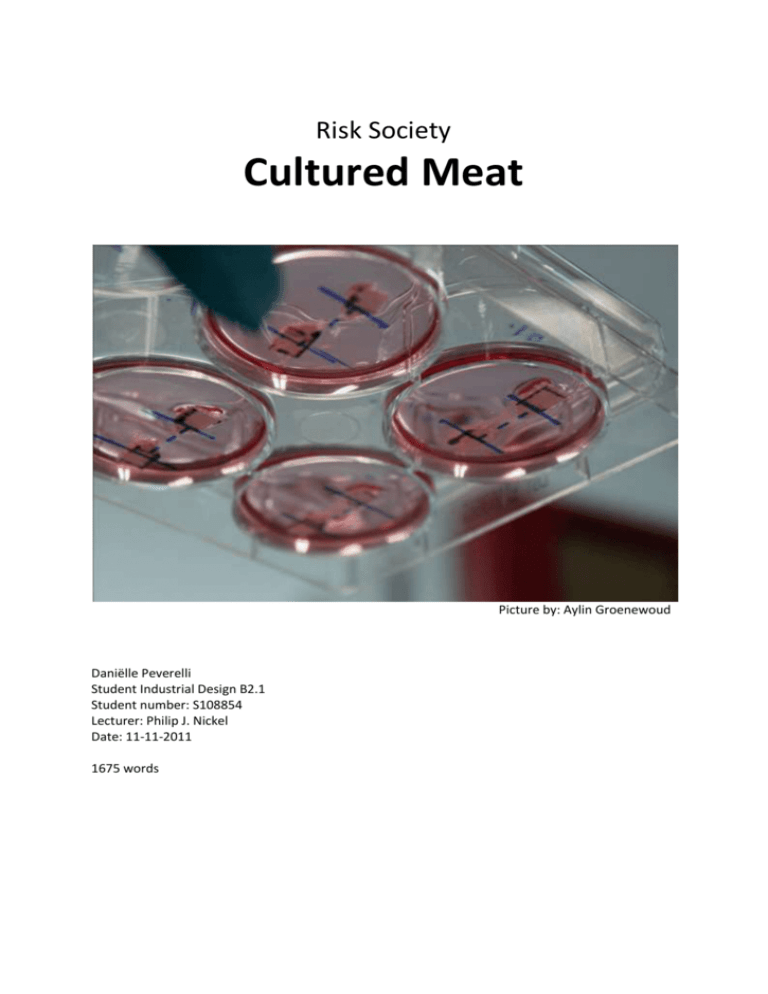
Risk Society Cultured Meat Picture by: Aylin Groenewoud Daniëlle Peverelli Student Industrial Design B2.1 Student number: S108854 Lecturer: Philip J. Nickel Date: 11-11-2011 1675 words Risk Society, Cultured Meat Daniëlle Peverelli Table of Content Page Content 3 Introduction, The product, Research question 4 Research and Process 5 Assessment Description and Validity, Risk evaluation 6 Conclusion 2 Risk Society, Cultured Meat Daniëlle Peverelli Introduction This paper will look into the risks the technique of making cultured meat have. These are researched, assessed, evaluated and in the end there is a recommendation for risk management. The product A new technique is emerging to provide us humans with meat. It is called “In Vitro Meat” or “Cultured Meat”. This technique grows a muscle out of a stem cell. The stem cell is placed on a petri dish along with collagen and two pieces of Velcro to mimic the environment where a muscle normally grows. The cells will form a connection between the two pieces of Velcro just like a normal muscle cells would grow between bones. These cells will be exercised with electric shocks to enlarge the muscle. This technique is called tissue engineering. Scientists have been able to make tiny pieces of mouse muscle so the technique is not yet ready for mass production of real cow or pork meat. Though scientists say we will have a real piece of cultured meat on our plates in the future. Research Question A societal risk analysis should be conducted because of the fact that this is a completely new technique we are dealing with. We know already a lot more about the medical application of growing stem cells but we do not know much about growing meat for consumption. To fully understand what we are dealing with and to answer the worrying questions people have an analysis should be conducted. Meat is closely linked to people’s health thus research into the risks of Cultured Meat is important. Stakeholders, people who eat meat, perceive significant risks at the moment. They ask themselves if it is safe and healthy to “play god” and grow our own meat. On the other hand scientists don’t perceive grave risks. They say this is the way to solve our meat production problem in the future. But are they cautious enough? The methods that are used in this paper to find more information about cultured meat’s risks are expert estimation, imagination and literature search. Expert estimation will give more insight to the way scientists think about this product. Literature research about the technique is needed to have a justified ground for the imagining the risks that could be a result of this new product. The research will be about the technique of growing cultured meat and the way it will be developed. 3 Risk Society, Cultured Meat Daniëlle Peverelli Research, and Process Literature search During the search a lot of clues were found as to the fact that people are afraid of this new technology. But the question is if tissue engineering really is safe and healthy or might it be dangerous? When a stem cell is not properly copied there might evolve an unwanted mutation so therefore tissue engineering would face the same dangers genetically modified products could have. When researching the health risks of genetically modified foods the article “what are the dangers of genetically modified food on health” explained this danger of Genetically modified food: ´ Several animal studies indicate serious health risks associated with genetically modified food," including infertility, immune problems, accelerated aging, faulty insulin regulation, and changes in major organs and the gastrointestinal system."1 Also when researching the technique of growing cultured meat an article was found , the path to the bloodless butcher, which indicated the fact that keeping the meat sterile might be not as easy as thought and might still need antibiotics. The article “the path to the bloodless butcher” states: “In vitro meat would likely require antibiotics to ensure sterility in the process. However, because the meat would be produced in a closed system rather than an open farm environment, the leakage of antibiotics from the bioreactor, as well as any bioreactor contamination that could cause environmental harm, would more likely be contained within a laboratory”2 Expert Estimation Daisy van der Schaft is one of the approxomatly five scientist in the world working on cultured meat. She explained just a small percentage of funding given to tissue engineering goes to the application of meat for consumption but mostly to the medical application. This is why research on cultured meat goes slowly and not many scientist work on it. Imagination There is some pressure behind getting cultured meat in our supermarkets. Because in 2050 we will not be able to match the meat-needs of the world. OurWorld 2.0 of the United Nation University already writes about it: “Artificial meat grown in vats may be needed if the 9 billion people expected to be alive in 2050 are to be adequately fed without destroying the earth, some of the world’s leading scientists report today.”3 This is why competitions are invented like the one from PETA4 ,where the first person who is able to grow cultured meat receives a prize of 1 million dollars. But the animal activists want it by 2012 which means if one wants to meet this deadline he or she needs to loosen some safety regulations while developing this technique. Also environmentalists and politicians want and need cultured meat to exist as soon as possible because this would lessen the strain on the environment. Therefore they could pressure the scientists to loosen the safety regulations which could result into a quite big chance on errors because of sloppy safety regulations. 1 http://www.livestrong.com/article/380764-what-are-the-dangers-of-genetically-modified-food-on-health/ 2 http://asutriplehelix.org/the_path_to_the_bloodless_butcher 3 http://ourworld.unu.edu/en/artificial-meat-food-for-thought-for-2050/ 4 http://www.peta.org/features/In-Vitro-Meat-Contest.aspx 4 Risk Society, Cultured Meat Daniëlle Peverelli Assessment Description and Validity Resulting from the research there can be concluded the main risks related to the technology of making cultured meat are: 1. Environmentalists, scientists and politicians want to get cultured meat as fast on the market as possible which might mean safety could be disregarded in the rush. 2. When something goes wrong with the duplicating of the stem cell it could have a very negative effect on the consumer’s health. 3. To keep bacteria away from the meat harmful substances like antibiotics might still be needed. The technique of growing cultured meat might have some risks related to the way the technique is developed. When scientist are not careful it could oppose quite big risks to the consumers of cultured meat. If cultured meat is put on the market too soon , because of environmental and animal rights motives, there could evolve a health hazard. When cells are duplicated wrongly it could change the genetic composition of the cell could change which would have a very negative effect on a person’s health like infertility, immune problems, accelerated aging, faulty insulin regulation, and changes in major organs and the gastrointestinal system. The risks explained in the previous paragraph are epistemic. We know a scenario like this might be possible but it is hard to figure out the likelihood because that depends on future man made decisions by governments and scientists. Therefore the scope of magnitude could range from imperceptible to endurable and personal to global. To give a more precise view on this risk, the research should be held a bit later on when scientists already know more about the technique of tissue engineering and have well formulated and well followed safety regulations. Then it would be easier to pinpoint the exact magnitude of the risk. Risk Evaluation The risk of where tissue engineering could lead to , as described in the risk assessment, fits to the risk class named Pythia. Which means the probability has large uncertainty intervals and the extend of the damage is potentially high. It is hard to predict how the technique will evolve but eating perpetrated genetically modified cultured meat could inflict high damage on the consumers health. Pythia, a simplification of the traffic light model of Renn, fits into the part of intermediate risk. Which means that the risk can ,and should, be reduced so therefore it is a tolerable risk. When against the best estimate principle5 is used to assess the maximin the risk management becomes clear. 5 Schrader-Frechette 1991 5 Risk Society, Cultured Meat Daniëlle Peverelli Against the best estimate principle: If product is quickly released on the market If there is a good safety policy No large effect on (11 u) environment. Global health will probably stay secure. (36 u) If there isn’t a good safety policy (10 u) No large effect on environment. Global health could be at risk. (4 u) If product is released on the market long after 2050 Might develop a few environmental problems because of the bio industry. Global health when eating cultured meat will probably stay secure. (16 u ) Might develop a few environmental problems because of the bio industry. Global health could be at risk. (-16 u) Apart from a safety policy, consumers will have the choice of eating cultured meat thus it will stay a personal one, only if the bio industry disappears it will be a societal choice. Therefore it depends on if the bio-industry is kept how big the voluntariness is of the consumer. The biggest uncertainty is the question if the safety policy is adequate and will lead to a safe technique. Conclusion The conclusion of this best estimate principle is; there has to be written down a good safety policy even if that will lead to the product being introduced to the consumers later than 2050. The safety policy should be the checking if the duplication of cells is correct, so there won’t occur unwanted genetic modifications which will affect the consumer’s health. The way risk management should diminish the risks that cultured meat apposes to the global health ,in relation to the technology and how this is developed, is by warning the consumers well enough so they can make a thorough decision for themselves. This means politics will need all the information possible about the product and should keep a close eye on the development of the technique. Even if cultured meat gets on the market then there need to be enough safety checks. Also it might be wise to give the customer a choice in the beginning of the introduction of cultured meat. Which means, when cultured meat is introduced, the bio-industry should stay the same until the technique is made perfect and has proven to be safe for the consumers health. 6



